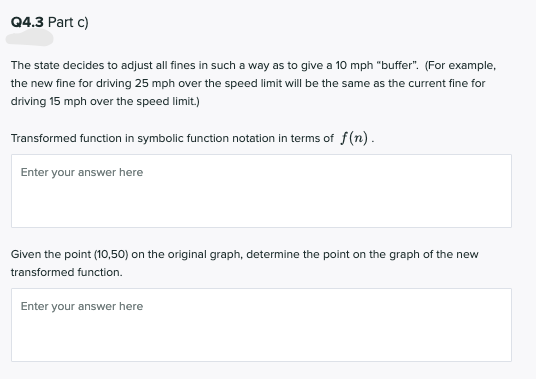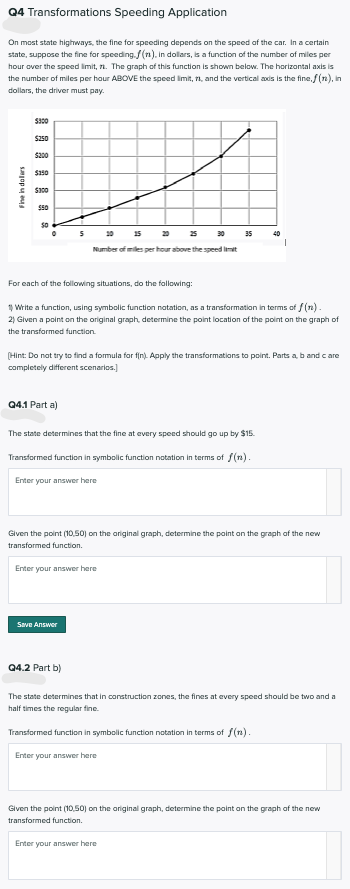Q4.3 Part c) The state decides to adjust all fines in such a way as to give a 10 mph "buffer". (For example, the new fine for driving 25 mph over the speed limit will be the same as the current fine for driving 15 mph over the speed limit.) Transformed function in symbolic function notation in terms of f(n). Enter your answer here Given the point (10,50) on the original graph, determine the point on the graph of the new transformed function. Enter your answer here Q4 Transformations Speeding Application On most state highways, the fine for speeding depends on the speed of the car. In a certain state, suppose the fine for speeding. f(n). in dollars, is a function of the number of miles per hour over the speed imit, n. The graph of this function is shown below. The horizontal axis is the number of miles per hour ABOVE the speed imit, n, and the vertical axdis is the fine,f (n), in dollars, the driver must pay. $250 $200 $50 25 20 20 15 20 35 Number of miles per hour above the speed limit For each of the following situations, do the following: 1 Write a function, using symbolic function natation, as a transformation in terms of f (n). 2) Given a point on the original graph, determine the point location of the point on the graph of the transformed function (Hint: Do nat try to find a formula for fin). Apply the transformations to point. Parts a b and care completely different scenarios.) Q4.1 Part a) The state determines that the fine at every speed should go up by $15. Transformed function in symbolic function notation in terms of f(n). Enter your answer here Given the point (10,50) on the ariginal graph, determine the point an the graph of the new transformed function. Enter your answer here Save Answer Q4.2 Part b) The state determines that in construction zones, the fines at every speed should be two and a half times the regular fine. Transformed function in symbolic function notation in terms of f(n). Enter your answer here Given the point (10,50) on the ariginal graph, determine the paint on the graph of the new transformed function. Enter your answer here
Q4.3 Part c) The state decides to adjust all fines in such a way as to give a 10 mph "buffer". (For example, the new fine for driving 25 mph over the speed limit will be the same as the current fine for driving 15 mph over the speed limit.) Transformed function in symbolic function notation in terms of f(n). Enter your answer here Given the point (10,50) on the original graph, determine the point on the graph of the new transformed function. Enter your answer here Q4 Transformations Speeding Application On most state highways, the fine for speeding depends on the speed of the car. In a certain state, suppose the fine for speeding. f(n). in dollars, is a function of the number of miles per hour over the speed imit, n. The graph of this function is shown below. The horizontal axis is the number of miles per hour ABOVE the speed imit, n, and the vertical axdis is the fine,f (n), in dollars, the driver must pay. $250 $200 $50 25 20 20 15 20 35 Number of miles per hour above the speed limit For each of the following situations, do the following: 1 Write a function, using symbolic function natation, as a transformation in terms of f (n). 2) Given a point on the original graph, determine the point location of the point on the graph of the transformed function (Hint: Do nat try to find a formula for fin). Apply the transformations to point. Parts a b and care completely different scenarios.) Q4.1 Part a) The state determines that the fine at every speed should go up by $15. Transformed function in symbolic function notation in terms of f(n). Enter your answer here Given the point (10,50) on the ariginal graph, determine the point an the graph of the new transformed function. Enter your answer here Save Answer Q4.2 Part b) The state determines that in construction zones, the fines at every speed should be two and a half times the regular fine. Transformed function in symbolic function notation in terms of f(n). Enter your answer here Given the point (10,50) on the ariginal graph, determine the paint on the graph of the new transformed function. Enter your answer here
Glencoe Algebra 1, Student Edition, 9780079039897, 0079039898, 2018
18th Edition
ISBN:9780079039897
Author:Carter
Publisher:Carter
Chapter9: Quadratic Functions And Equations
Section9.9: Combining Functions
Problem 11CYU
Related questions
Question
Can you help me with this?

Transcribed Image Text:Q4.3 Part c)
The state decides to adjust all fines in such a way as to give a 10 mph "buffer". (For example,
the new fine for driving 25 mph over the speed limit will be the same as the current fine for
driving 15 mph over the speed limit.)
Transformed function in symbolic function notation in terms of f(n).
Enter your answer here
Given the point (10,50) on the original graph, determine the point on the graph of the new
transformed function.
Enter your answer here

Transcribed Image Text:Q4 Transformations Speeding Application
On most state highways, the fine for speeding depends on the speed of the car. In a certain
state, suppose the fine for speeding. f(n). in dollars, is a function of the number of miles per
hour over the speed imit, n. The graph of this function is shown below. The horizontal axis is
the number of miles per hour ABOVE the speed imit, n, and the vertical axdis is the fine,f (n), in
dollars, the driver must pay.
$250
$200
$50
25 20
20
15
20
35
Number of miles per hour above the speed limit
For each of the following situations, do the following:
1 Write a function, using symbolic function natation, as a transformation in terms of f (n).
2) Given a point on the original graph, determine the point location of the point on the graph of
the transformed function
(Hint: Do nat try to find a formula for fin). Apply the transformations to point. Parts a b and care
completely different scenarios.)
Q4.1 Part a)
The state determines that the fine at every speed should go up by $15.
Transformed function in symbolic function notation in terms of f(n).
Enter your answer here
Given the point (10,50) on the ariginal graph, determine the point an the graph of the new
transformed function.
Enter your answer here
Save Answer
Q4.2 Part b)
The state determines that in construction zones, the fines at every speed should be two and a
half times the regular fine.
Transformed function in symbolic function notation in terms of f(n).
Enter your answer here
Given the point (10,50) on the ariginal graph, determine the paint on the graph of the new
transformed function.
Enter your answer here
Expert Solution
This question has been solved!
Explore an expertly crafted, step-by-step solution for a thorough understanding of key concepts.
This is a popular solution!
Trending now
This is a popular solution!
Step by step
Solved in 4 steps with 4 images

Recommended textbooks for you

Glencoe Algebra 1, Student Edition, 9780079039897…
Algebra
ISBN:
9780079039897
Author:
Carter
Publisher:
McGraw Hill

Algebra and Trigonometry (MindTap Course List)
Algebra
ISBN:
9781305071742
Author:
James Stewart, Lothar Redlin, Saleem Watson
Publisher:
Cengage Learning

College Algebra
Algebra
ISBN:
9781305115545
Author:
James Stewart, Lothar Redlin, Saleem Watson
Publisher:
Cengage Learning

Glencoe Algebra 1, Student Edition, 9780079039897…
Algebra
ISBN:
9780079039897
Author:
Carter
Publisher:
McGraw Hill

Algebra and Trigonometry (MindTap Course List)
Algebra
ISBN:
9781305071742
Author:
James Stewart, Lothar Redlin, Saleem Watson
Publisher:
Cengage Learning

College Algebra
Algebra
ISBN:
9781305115545
Author:
James Stewart, Lothar Redlin, Saleem Watson
Publisher:
Cengage Learning


Holt Mcdougal Larson Pre-algebra: Student Edition…
Algebra
ISBN:
9780547587776
Author:
HOLT MCDOUGAL
Publisher:
HOLT MCDOUGAL

Trigonometry (MindTap Course List)
Trigonometry
ISBN:
9781337278461
Author:
Ron Larson
Publisher:
Cengage Learning